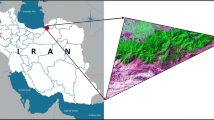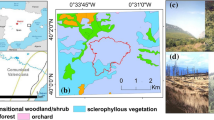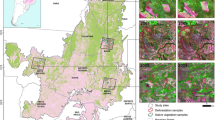Abstract
According to the forest statistic data, the forest degradation in West Kalimantan has been increasing since 2006. The satellite remote sensing data can provide information more effective and economical input rather than direct field observation that is difficult to access. In this research, we applied a spectral index derived from remote sensing satellite data, the Normalized Difference Fraction Index (NDFI), then compared it with the widely used forest degradation index, the Normalized Burn Ratio (NBR) and the Normalized Difference Vegetation Index (NDVI), in order to have an enhanced detection of forest canopy damage caused by selective logging activities and associated forest fires in West Kalimantan, especially in Kapuas Hulu and Sintang districts. The NDFI was derived from combination of green vegetation, shadow, soil, and non-photosynthetic vegetation (NPV) fractions images from spectral mixture analysis model. The NBR and NDVI were generated from spectral reflectance values of near-infrared, shortwave infrared, and red spectrums. The satellite data used for monitoring forest degradation were Landsat-year 2006–2009 and then continued with 4-year SPOT 2009–2012. The result showed that the forest degradation was detected initially in 2008 up to 2012 in the research area. Spectral indices analysis (NDFI, NBR, NDVI) was tested and verified by ground survey data in 2012. We found that NDFI has higher accuracy (95 %) to classify the degradation forest due to logging and burning activities rather than NBR or NDVI. The forest degradation mapping also conducted using mosaic of Landsat data year 2000–2009 for whole of West Kalimantan province. This method is suitable for a forest degradation monitoring tool in tropical rainforest.








Similar content being viewed by others
References
Achard F, Hansen MC (2012) Global forest monitoring from earth observation. CRC Press, Boca Raton
Adams JB, Smith MO, Gillespie AR (1993) Imaging spectroscopy: interpretation based on spectral mixture analysis. In: Pieters CM, Englert P (eds) Remote geochemical analysis: elements and mineralogical composition. Cambridge Univ. Press, New York, pp 145–166
Adams JB, Sabol DE, Kapos V, Almeida Filho R, Robert D, Smith MO, Gillespie AR (1995) Classification of multispectral images based on fractions of endmembers: application to land-cover change in the Brazilian Amazon. Remote Sens Environ 52:137–154
Adams JB, Gillespie AR (2006) Remote sensing of landscapes with spectral images: a physical modeling approach. Cambridge University Press, Cambridge
Asner GP, Keller M, Pereira R Jr, Zweede JC (2002) Remote sensing of selective logging in Amazonia: assessing limitations based on detailed field observations, Landsat ETM + and textural analysis. Remote Sens Environ 80:83–496
Bajracharya S (2008) Community carbon forestry: remote sensing of forest carbon and forest degradation in Nepal. Thesis, International Institute for Geo-Information Science and Earth Observation, Enschede
Barbosa PM, Pereira JMC, Grégoire JM (1998) Compositing criteria for burned area assessment using multitemporal low resolution satellite data. Remote Sens Environ 65:38–49
BPS (2012) Statistics of West Kalimantan
Chander G, Markham BL, Helder DL (2009) Summary of current radiometric calibration coefficients for Landsat MSS, TM, ETM + , and EO-1 ALI sensors. Remote Sens Environ 113:893–903
Chuvieco E, Ventura G, Pilar Martín M, Gomez I (2005) Assessment of multitemporal compositing techniques of MODIS and AVHRR images for burned land mapping. Remote Sens Environ 94:450–462
Cochrane MA, Alencar A, Schulze M, Souza C Jr, Nepstad D, Lefebvre P, Davidson E (1999) Positive feedbacks in the fire dynamic of closed canopy tropical forest. Science 284:1832–1835
Cocke AE, Fule PZ, Crouse JE (2005) Comparison of burn severity assessments using differenced normalized burn ratio and ground data. Int J Wildl Fire 14:189–198
Conese C, Bonora L (2005) Burned land mapping from remote sensing imagery. Pecora 16 “global priorities in land remote sensing”, 23–27 Oct 2005, Sioux Falls, South Dakota
Cox PM, Pearson D, Booth BB, Pierre F, Huntingford C, Jones CD, Luke CM (2013) Sensitivity of tropical carbon to climate change constrained by carbon dioxide variability. Nature 494:341–344. doi:10.1038/nature11882
Edwards AJ (1999) Application of satellite and airborne image data to coastal management (seventh computer-based learning module). UNESCO, Paris
Escuin S, Navarro R, Fernandez P (2008) Fire severity assessment by using NBR (normalized burn ratio) and NDVI (Normalized Difference Vegetation Index) derived from LANDSAT TM/ETM images. Int J Remote Sens 29:1053–1073
Fuller DO, Fulk M (2001) Burned area in Kalimantan, Indonesia mapped with NOAA-AVHRR and Landsat TM imagery. Int J Remote Sens 22:691–697
Gerwing JJ (2002) Degradation of forests through logging and fire in theeastern Brazilian Amazon. For Ecol Manag 157(1):131–141
Heiskanen J (2006) Estimating aboveground tree biomass and leaf area index in a mountain birch forest using ASTER satellite data. Int J Remote Sens 27(6):1135–1158
Hogg RV, Craig AT (1994) Introduction to mathematical statistic. Prentice Hall PTR, Englewood Cliffs
Huete A, Didan K, Miura T, Rodriguez EP, Gao X, Ferreira LG (2002) Overview of the radiometric and biophysical performance of the MODIS vegetation indices. Remote Sens Environ 83:195–213
Jensen JR (1986) Introductory digital image processing. Prentice-Hall, Englewood Cliffs
Johns J, Barreto P, Uhl C (1996) Logging damage in planned and unplanned logging operation and its implications for sustainable timber production in the eastern Amazon. For Ecol Manag 89:59–77
Key CH, Benson NC (1999) Measuring and remote sensing of burn severity. In: Neuenschwander LF, Ryan KC (eds) Joint fire science conference and workshop, proceedings, vol II. University of Idaho and International Association of Wildland Fire
Lanly J (2003) Deforestation and forest degradation factors. In: XII World Forestry
Martín MP, Díaz-Delgado R, Chuvieco E, Ventura G (2002) Burned land mapping using NOAA-AVHRR and TERRA-MODIS. In: Viegas (ed) Conference proceedings: forest fire research and wildland fire safety. Millpress, Rotterdam
Miettinen J (2007) Burnt area mapping in insular Southeast Asia using medium resolution satellite imagery. Academic dissertation. Department of Forest Resource Management Faculty of Agriculture and Forestry University of Helsinki
Miller JD, Yool SR (2002) Mapping forest post-fire canopy consumption in several overstory types using multi-temporal Landsat TM and ETM data. Remote Sens Environ 82:481–496
Ministry of Forestry (2012) Forestry statistic. Water Catchment Management and Social Forestry Directory, Indonesia
Ministry of Forestry (2013) Forestry statistic. Planology Directory, Indonesia
Nepstad DC, Veríssimo JA, Alencar A, Nobre C, Lima E, Lefebvre P, Schlesinger P, Potter C, Moutinho P, Mendoza E, Cochrane M, Brooks V (1999) Large-scale impoverishment of Amazonian forests by logging and fire. Int Wkly J Sci Nat 398:504–508
Nielsen TT, Mbow C, Kane R (2002) A statistical methodology for burned area estimation using multitemporal AVHRR data. Int J Remote Sens 23:1181–1196
Ott L (1992) An introduction to statistical methods and data analysis, 4th edn. California’ Duxbury Press, Belmont, 1051 pp
Pinty B, Verstraete MM (1992) GEMI: a non-linear index to monitor global vegetation from satellites. Vegetatio 101:15–20
Roberts DA, Batista GT, Pereira JLG, Walker EK, Nelson BW (1998) Change identification using multitemporal Spectral Mixture Analysis: Applications in eastern Amazon. In: Luneetta RS, Elvidge CD (eds) Remote sensing change detection: environmental monitoring methods and applications, vol 9. Ann Arbor Press, Chelsea, pp 137–159
Rouse JW, Hass RH, Schell JA, Deering DW (1973) Monitoring vegetation system in Great Plains with ERTS. In: Third earth resources technology satellite-1 symposium, 10–14 Dec 1973, Washington DC, NASA, pp 309–317
Roy DP, Giglio L, Kendall JD, Justice CO (1999) Multi-temporal active-fire based burn scar detection algorithm. Int J Remote Sens 20:1031–1038
Roy DP, Lewis PE, Justice CO (2002) Burned area mapping using multi-temporal moderate spatial resolution data—a bi-directional reflectance model-based expectation approach. Remote Sensing and Environment 83:263–286
Sá ACL, Pereira JMC, Vasconcelos MJP, Silva JMN, Ribeiro N, Awasse A (2003) Assessing the feasibility of sub-pixel burned area mapping in miombo woodlands of Northern Mozambique using MODIS imagery. Int J Remote Sens 24:1783–1796
Shimabukuro YE, Batista GT, Mello EMK, Moreira JC, Duarte V (1998) Using shade fraction image segmentation to evaluate deforestation in Landsat Thematic Mapper images of the Amazon Region. Int J Remote Sens 19(3):535–541
Silva JMN, Cadima JFCL, Pereira JMC, Grégoire JM (2004) Assessing the feasibility of a global model for multitemporal burned area mapping using SPOT-VEGETATION data. Int J Remote Sens 25:4889–4913
Sofan P, Zubaidah A, Vetrita Y, Yulianto F, Diah SKA (2011) Remote sensing application for mapping the burnt area. Internal report of National Institute of Aeronautics and Space (LAPAN) (in Bahasa Indonesia)
Souza C, Barreto P (2000) An alternative approach for detecting and monitoring selectively logged forests in the Amazon. Int J Remote Sens 21:173–179
Souza C Jr, Firestone L, Silva ML, Roberts DA (2003) Mapping forest degradation in the Eastern Amazon from SPOT 4 through spectral mixture models. Remote Sens Environ 87:494–506
Souza C Jr, Roberts DA, Cochrane MA (2005) Combining spectral and spatial information to map canopy damage from selective logging and forest fires. Remote Sens Environ 98:329–343
Stone TA, Lefebvre PA (1998) Using multi-temporal satellite data to evaluate selective logging in Para, Brazil. Int J Remote Sens 13:2517–2526
Stroppiana D, Pinnock S, Pereira JMC, Grégoire JM (2002) Radiometric analysis of SPOT-VEGETATION images for burnt area detection in Northern Australia. Remote Sens Environ 82:21–37
Suwarsono, Yulianto F, Parwati, Suprapto T (2009) The application of MODIS data for identifying burned area based on NDVI changes in Central Kalimantan Province. J Remote Sens Digit Image Process 6:54–64 (in Bahasa Indonesia)
Suwarsono, Vetrita Y, Parwati, Khomarudin R (2011) Analysis of burned area in Central Kalimantan in 2009 using Normalized Burned Ratio from Landsat 7 SLC-off. In: Proceeding of geospatial in development of region and city. Annual scientific conference. Indonesian Society for Remote Sensing (ISRS) (in Bahasa Indonesia)
Turner II BL, Moss RH, Skole DL (1993) Relating land use and global land-cover change: a proposal for an IGBP–HDP core project. IGBP report no. 24, HDP report no. 5. International Geosphere–Biosphere Programme, Stockholm
Veríssimo A, Barreto P, Mattos M, Tarifa R, Uhl C (1992) Logging impacts and prospects for sustainable forest management in an old Amazon frontier: the case of Paragominas. For Ecol Manag 55:169–199
Veríssimo A, Barreto P, Tarifa R, Uhl C (1995) Extraction of a high-value natural resource from Amazon: the case of mahogany. For Ecol Manag 72:39–60
Verolme HJH, Moussa J (1999) Addressing the underlying causes of deforestation and forest degradation—case studies, analysis and policy recommendations. Biodiversity Action Network, Washington
Wu X, Furby SL, Wallace JF (2004) An approach for terrain illumination correction. In: The 12th Australian remote sensing and photogrammetry conference proceedings, Fremantle, WA
Acknowledgments
This research was conducted in Remote Sensing Applications Center—LAPAN. Thanks go to Mr. Agus Hidayat, M.Sc. (The former Director of Remote Sensing Application Center, LAPAN) and Mr. Dedi Irawadi (The Director of Remote Sensing Application Center, LAPAN) who has supported this research. The author also would like to thanks to Indonesian National Carbon Accounting (INCAS) Project in Technology and Remote Sensing Data Center who support Landsat-7 data and also SPOT-4 data.
Author information
Authors and Affiliations
Corresponding author
Rights and permissions
About this article
Cite this article
Sofan, P., Vetrita, Y., Yulianto, F. et al. Multi-temporal remote sensing data and spectral indices analysis for detection tropical rainforest degradation: case study in Kapuas Hulu and Sintang districts, West Kalimantan, Indonesia. Nat Hazards 80, 1279–1301 (2016). https://doi.org/10.1007/s11069-015-2023-0
Received:
Accepted:
Published:
Issue Date:
DOI: https://doi.org/10.1007/s11069-015-2023-0




